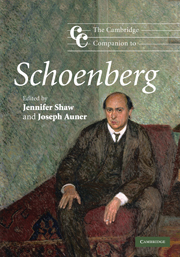Book contents
- Frontmatter
- 1 Introduction
- Part I Schoenberg's early years
- Part II Schoenberg, modernism, and modernity
- Part III Schoenberg between the World Wars
- Part IV Schoenberg's American years
- 15 Cadence after thirty-three years: Schoenberg's Second Chamber Symphony, Op. 38
- 16 Schoenberg's collaborations
- 17 Listening to Schoenberg's Piano Concerto
- 18 Schoenberg reception in America, 1933–51
- 19 Schoenberg: dead or alive? His reception among the postwar European avant-garde
- Notes
- Select bibliography
- Index
15 - Cadence after thirty-three years: Schoenberg's Second Chamber Symphony, Op. 38
from Part IV - Schoenberg's American years
Published online by Cambridge University Press: 28 September 2011
- Frontmatter
- 1 Introduction
- Part I Schoenberg's early years
- Part II Schoenberg, modernism, and modernity
- Part III Schoenberg between the World Wars
- Part IV Schoenberg's American years
- 15 Cadence after thirty-three years: Schoenberg's Second Chamber Symphony, Op. 38
- 16 Schoenberg's collaborations
- 17 Listening to Schoenberg's Piano Concerto
- 18 Schoenberg reception in America, 1933–51
- 19 Schoenberg: dead or alive? His reception among the postwar European avant-garde
- Notes
- Select bibliography
- Index
Summary
In 1939 Arnold Schoenberg resumed work on his Second Chamber Symphony, a composition he had first started thirty-three years earlier. Thus Schoenberg, that quintessential Modernist, was confronted directly with a prototypical issue of contemporary composition: what is the underlying sense of writing tonal music after the atonal and twelve-tone revolutions that he himself initiated and brought to fulfillment? Was the Second Chamber Symphony, far from being a retrogressive exercise in nostalgia as suggested by many Modernist scholars and composers, a step forward for him instead? In what follows, I will discuss ways in which Schoenberg indeed employed hitherto unexplored tonal structures and even alluded to serial procedures. These features are evident in particular in the codas and cadences of each movement, which he composed in 1939, notably the same passages he failed to complete in 1906–08 when he first worked on the piece, or when he returned to it in 1911 and 1916.
Yet, paradoxically, the work's final triad is presented in a virtually identical fashion to that of “Litanei” (Litany), the third movement of the Second String Quartet, Op. 10, composed in 1908. Both works end with an extremely low E flat minor triad swelling in crescendo, only to break off into abrupt silence. Stefan George's poem “Litanei” is a prayer for an end to earthly misery. In 1908 Schoenberg followed his setting of “Litanei” with his first major atonal work – the renowned interpretation of George's “Entrückung” (Transport), which describes the transport of the soul from earthly suffering to transcendent ecstasy.
- Type
- Chapter
- Information
- The Cambridge Companion to Schoenberg , pp. 207 - 225Publisher: Cambridge University PressPrint publication year: 2010



